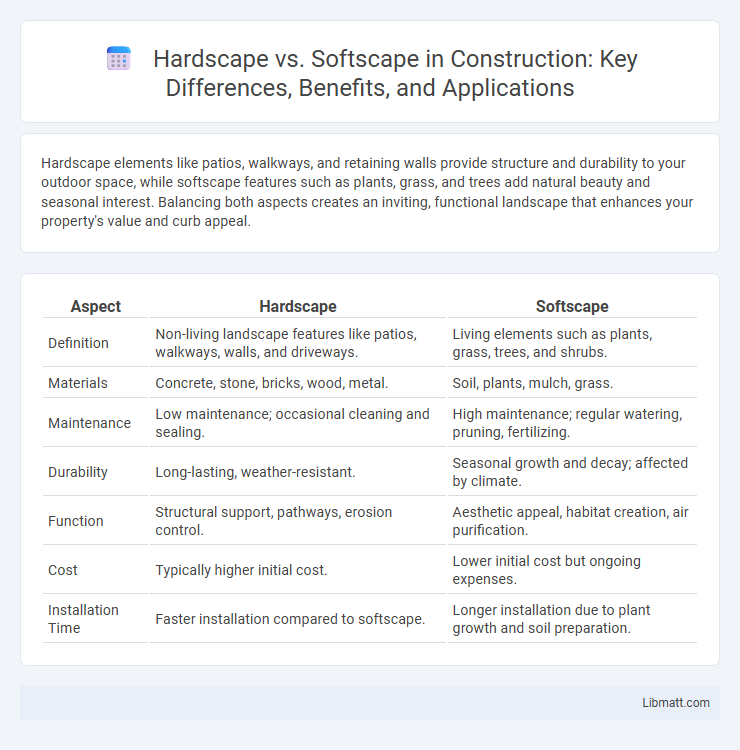Hardscape elements like patios, walkways, and retaining walls provide structure and durability to your outdoor space, while softscape features such as plants, grass, and trees add natural beauty and seasonal interest. Balancing both aspects creates an inviting, functional landscape that enhances your property's value and curb appeal.
Table of Comparison
| Aspect | Hardscape | Softscape |
|---|---|---|
| Definition | Non-living landscape features like patios, walkways, walls, and driveways. | Living elements such as plants, grass, trees, and shrubs. |
| Materials | Concrete, stone, bricks, wood, metal. | Soil, plants, mulch, grass. |
| Maintenance | Low maintenance; occasional cleaning and sealing. | High maintenance; regular watering, pruning, fertilizing. |
| Durability | Long-lasting, weather-resistant. | Seasonal growth and decay; affected by climate. |
| Function | Structural support, pathways, erosion control. | Aesthetic appeal, habitat creation, air purification. |
| Cost | Typically higher initial cost. | Lower initial cost but ongoing expenses. |
| Installation Time | Faster installation compared to softscape. | Longer installation due to plant growth and soil preparation. |
Understanding Hardscape: Definition and Elements
Hardscape refers to the non-living elements of landscape design, including materials such as stone, concrete, brick, and wood used to create structures like patios, walkways, retaining walls, and driveways. These components provide functional and aesthetic framework in outdoor spaces, often defining boundaries and supporting plant growth. Key elements of hardscape enhance durability, accessibility, and overall landscape architecture, balancing the natural aspects of the garden.
What is Softscape? Key Features and Components
Softscape refers to the living elements of landscape design, including plants, trees, shrubs, flowers, grass, and soil. Key features of softscape involve the use of natural materials that grow and change with the seasons, contributing to the ecosystem and aesthetic appeal of your outdoor space. Components such as mulch, fertilizers, and irrigation systems support plant health and growth, making softscape vital for a vibrant and sustainable landscape.
Hardscape vs Softscape: Key Differences
Hardscape refers to the non-living elements in landscaping, such as stone pathways, patios, retaining walls, and driveways, while softscape encompasses living components like plants, trees, shrubs, and grass. The key differences lie in their functionality and maintenance requirements; hardscape provides structure and durability supporting the landscape design, whereas softscape enhances aesthetic appeal and environmental benefits, including oxygen production and soil stabilization. Effective landscape design balances hardscape and softscape by integrating durable materials with vibrant plant life to create visually appealing and sustainable outdoor spaces.
Benefits of Hardscape in Landscaping
Hardscape elements such as patios, walkways, and retaining walls provide durable, low-maintenance structures that enhance outdoor living spaces and increase property value. They improve functionality by creating defined areas for relaxation and entertainment while effectively controlling erosion and drainage. Incorporating hardscape in your landscaping ensures year-round usability and reduces water consumption compared to softscape elements like plants and lawns.
Advantages of Softscape for Outdoor Spaces
Softscape enhances outdoor spaces by promoting biodiversity, improving air quality, and providing natural shade that lowers ambient temperatures. Plants and trees increase aesthetic appeal while supporting local ecosystems and reducing soil erosion through root systems. Softscape elements also contribute to mental well-being by creating calming, green environments conducive to relaxation and stress reduction.
Design Considerations: Balancing Hardscape and Softscape
Balancing hardscape and softscape in landscape design requires careful consideration of functionality, aesthetics, and environmental impact. Hardscape elements like patios and walkways provide structure and durability, while softscape components such as plants and lawns add texture, color, and life to your outdoor space. Achieving harmony between both creates a cohesive design that enhances usability and complements the natural surroundings.
Maintenance Requirements: Hardscape vs Softscape
Hardscape elements such as patios, walkways, and retaining walls typically demand less frequent maintenance, mainly involving cleaning and occasional repairs. Softscape features like lawns, flower beds, and shrubs require regular watering, pruning, fertilizing, and pest control to remain healthy and vibrant. Understanding the distinct maintenance needs of hardscape versus softscape can help you plan a sustainable and manageable outdoor space.
Cost Comparison: Hardscape vs Softscape Installations
Hardscape installations, such as patios, retaining walls, and driveways, typically involve higher upfront costs due to materials like stone, concrete, and labor-intensive construction. Softscape elements, including plants, grass, and mulch, generally have lower initial expenses but may incur higher ongoing maintenance costs like watering, pruning, and seasonal replacements. Evaluating long-term expenses reveals that hardscaping offers durability and lower maintenance costs, while softscaping demands continual investment in upkeep and replacement.
Environmental Impact: Sustainable Choices in Landscaping
Hardscape elements like concrete and stone have a higher environmental impact due to resource extraction and heat retention, while softscape features such as native plants promote biodiversity and improve soil health. Choosing permeable materials for paths and patios reduces runoff, supporting local water cycles and minimizing pollution. Your sustainable landscaping choices can significantly lower ecological footprints and create a balanced, eco-friendly outdoor space.
Choosing the Right Mix for Your Landscape
Balancing hardscape and softscape elements creates a harmonious and functional landscape that enhances outdoor living spaces. Hardscape features such as patios, walkways, and retaining walls provide structure and durability, while softscape components like plants, trees, and lawns add natural beauty and ecological benefits. Choosing the right mix for your landscape depends on your aesthetic preferences, maintenance capacity, and the specific environmental conditions of your property.
Hardscape vs softscape Infographic

 libmatt.com
libmatt.com